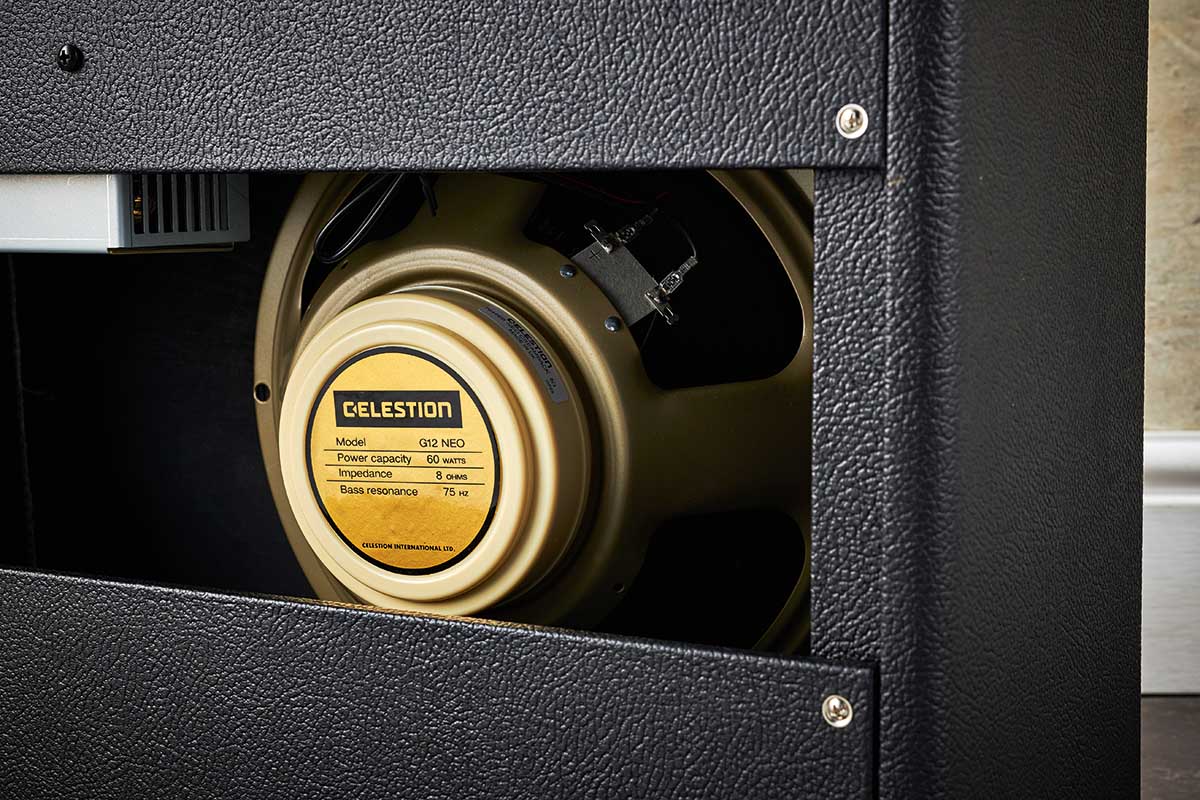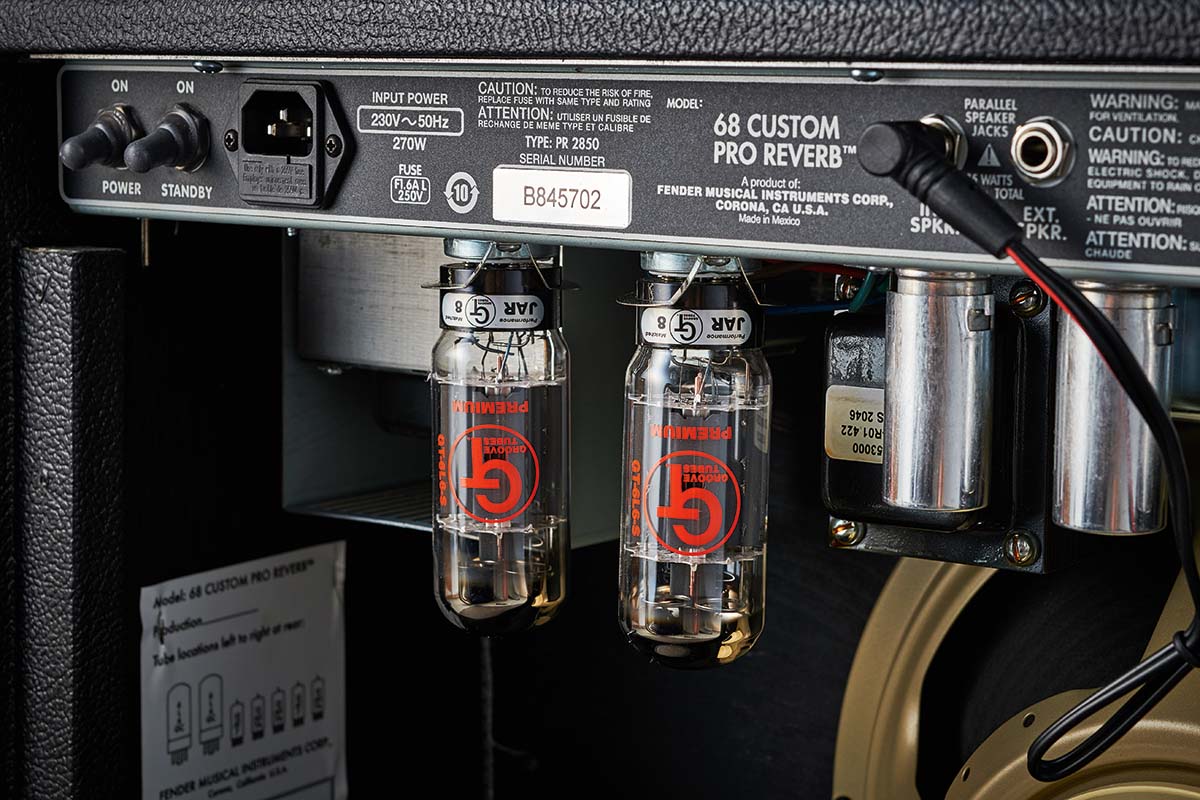Guitar World Verdict
A desert island amp for pros and serious amateurs? Quite possibly: this combo takes the scenic route through classic American guitar tones and offers a superb platform for pedalboards.
Pros
- +
Authentic American clean and mild overdrive tone.
- +
Superlative reverb and tremolo effects.
- +
Build quality.
Cons
- -
One minor disappointment at this price is the lack of a pair of tilt-back legs.
You can trust Guitar World
With arguably the world’s richest guitar amplification legacy, Fender can hardly be blamed for occasionally looking to its own back catalogue for a little inspiration. Fender’s classic early 60s black-panel amplifiers are universal benchmarks for American guitar tone, responsible for countless hit records and the industry-standard backline on the world’s stages for decades.
We all know the star turns from this era such as the mighty Twin Reverb with its quartet of 6L6 valves, and the Deluxe Reverb, powered by a pair of 6V6s driving a single 12-inch speaker – ideal for studios and smaller venues.
Sat in between these two legends were the 4x10 Super Reverb and, from 1965 onwards, the less well known and slightly less powerful Pro Reverb, featuring a pair of 12-inch speakers and a dual 6L6 output stage, producing around 40 watts into a slightly smaller output transformer than the Super.
The original’s coveted blend of medium headroom, 6L6 clarity and squashy dynamic response has been enhanced
While these weren’t in the spotlight as much as the Twin and Deluxe, early Pro Reverbs had – and still have – a fiercely loyal fanbase, many of whom consider them to be the best amps Fender ever made, and by extension the best amps anyone has ever made, with the sweetest tone and a perfect balance of power and headroom.
Taking its cue from that combo is Fender’s new ’68 Custom Pro Reverb, which joins the ’68 Custom range together with the new ’68 Custom Vibro Champ Reverb. Not just straight reissues, these ’68 Customs are refined and upgraded to be more in keeping with modern demands without sacrificing the tone and character of the originals.

The ’68 Custom Pro Reverb is as handsome a Fender as we’ve ever seen. The company has revisited the styling from that specific year, combining blue graphics on a silver control panel with a silver and blue sparkle grille cloth.
The grille has an aluminium ‘drip edge surround’, a distinctive feature that appeared between 1967 and 1969, with 1968 thought to be the only full year of ‘drip edge’ production. The rest of the construction is typical 60s Fender, with a solid ply cabinet covered in thick black Tolex and a hefty steel box chassis secured by four bolts, reinforced with chrome strap washers.
All the latest guitar news, interviews, lessons, reviews, deals and more, direct to your inbox!
Inside the chassis, the electronics are a mix of PCB and hand wiring. There are two main circuit boards: one behind the control panel supporting the control pots and switches, and a larger board that holds most of the preamp, power amp and power supply components.
The ’68 Custom Pro Reverb is a one-channel design, based on the classic Fender ‘Vibrato’ channel, with two input jacks, a Bright switch and an added midrange control
Meanwhile, the valve bases are all chassis-mounted and hand-wired just like the originals, keeping heat away from the PCBs and vastly improving reliability. There are three 12AX7 and two 12AT7 preamp valves, along with a matched pair of Groove Tubes 6L6-S valves providing the power.
The first Pro Reverbs used a GZ34 rectifier valve, which was replaced with a 5U4 on later iterations, followed by silicon diodes. The ’68 Custom Pro Reverb uses silicon for reliability and consistency, but its custom Schumacher transformers have been specially designed to add some elusive ‘sag’ and the negative feedback has been reduced, further enhancing the dynamic response.

The ’68 Custom Pro Reverb is a one-channel design, based on the classic Fender ‘Vibrato’ channel, with two input jacks, a Bright switch and an added midrange control, something that didn’t appear on the originals. There’s a level control for the traditional valve-powered spring reverb, together with Speed and Intensity controls for the valve-powered tremolo effect, which sits after the reverb in the output stage, modulating volume via the grid bias.
The other big change is the transition from two speakers to one – a single 12-inch Celestion Neo Creamback. This reduces the cabinet size to slightly less than Deluxe Reverb proportions and keeps the weight down, making the ’68 Custom Pro Reverb a tough yet portable combo that’s easily carried with one hand.

Feel & Sounds
We used our regular PAF-equipped Les Paul and Duncan APS-loaded Strat, and after a little experimenting we settled with leaving the volume and tone controls all roughly on 6, with the Bright switch set to ‘on’ for our Les Paul and ‘off’ for the Strat. The sweet treble, balanced mids and extended bass are great for jazz, country and pop, while the reverb and tremolo are like taking a journey through American pop culture.
Low settings on the spring add subtle ambience and smokey, diffused jazz-club warmth, while the halfway mark is full-on Americana, conjuring up visions of dust-coated pickup trucks, tumbleweeds and endless desert highways punctuated with Googie-styled gas stations and motels.
The sweet treble, balanced mids and extended bass are great for jazz, country and pop, while the reverb and tremolo are like taking a journey through American pop culture
Pushing the reverb higher still takes you to surf city, with cavernous delay and ping-pong oscillation nailing the Dick Dale tone. The tremolo is equally evocative, from dark, brooding slow pulses to Bo Diddley stutter at full speed.
The tremolo ‘vibrato’ circuit works on the output power stage’s grid bias, modulating the reverb tail as well as the guitar signal for authentic vintage tones, and it behaves very dynamically, with the effect becoming more noticeable the quieter the guitar is played, and less apparent as you dig in hard.

The original Pro Reverb’s coveted blend of medium headroom, 6L6 clarity and squashy dynamic response has not only been retained but enhanced, with a wider dynamic range on the ’68 Custom thanks to that reduction in negative feedback and some clever work on the transformers.
The amp stays clean up until around 4 on the volume control, after which the output stage distortion builds from a subtle chime at around 4 or 5, to a toothsome crunch with the volume maxed out.
Original Pro Reverbs could sound a little mushy when driven hard, but the ’68 Custom’s Celestion Neo Creamback adds extra focus and definition – it’s a truly superb driver, blending the low-end thump of 60s G12s with a woody midrange and complex treble that rivals the Alnico Gold.

Verdict
The ’68 Custom Pro Reverb might be brand-new, but it’s chock-full of vintage American tone and shares the perfectly balanced power of its ancestor, with ample headroom for country twang and yet not so much that you lose those organic squashy dynamics needed for blues and classic rock. As well as sounding great on its own, it’s also a superb platform for pedals, although once you’ve heard the Pro’s monster reverb and tremolo, your pedalboard could possibly be taking an extended holiday.
While both effects are footswitchable, there are no other concessions to modern functionality: effects loops, boosts and other tone- altering features are absent, which is great, because when an amp sounds this good, you simply don’t need them. It really looks the part, too. The smart late-60s visuals exude a retro-modern cool vibe that’s very much ‘in’ at the moment.
This brand-new model is chock-full of vintage American tone and shares the perfectly balanced power of its ancestor
We’re obviously in a different league here compared with an all-digital mass-produced combo, and that’s reflected in the price. However, we think Fender’s ’68 Custom Pro Reverb could easily end up being the perfect desert island amp for many pro and dedicated amateur guitarists.
For sheer quality of tone, the price is more than fair – when you add in the robust build quality and classic styling, things become more than a little tempting. With those compact proportions and easy handling, it’s a perfect partner for home, studio and stage.
Specs
- PRICE: $1,299 / £1,349
- ORIGIN: Mexico
- TYPE: All valve preamp and power amp
- OUTPUT: 40W RMS
- VALVES: 3x 12AX7, 2x 12AT7, 2x 6L6-S
- DIMENSIONS: 435 (h) x 570 (w) x 238mm (d)
- WEIGHT (kg/lb): 16/35
- CABINET: Birch ply
- LOUDSPEAKERS: 1x12” Celestion G12 Neo Creamback
- CHANNELS: 1
- CONTROLS: Bright switch, Volume, Bass, Middle, Treble, Reverb level, vibrato Speed and Intensity
- FOOTSWITCH: Supplied vintage 2-button switch, toggles reverb and vibrato effects (needs to be plugged in for vibrato to work)
- ADDITIONAL FEATURES: Valve-powered spring reverb, valve tremolo ‘vibrato’ effect, external speaker jack
- OPTIONS: None
- RANGE OPTIONS: The other new addition to the ’68 Custom range is the 5W ’68 Custom Vibro Champ (£799). Other ’68 Custom amps include the Princeton Reverb (£1,049), Deluxe Reverb (£1,299) and Twin Reverb (£1,599)
- CONTACT: Fender
Nick Guppy was Guitarist magazine's amp guru for over 20 years. He built his first valve amplifier at the age of 12 and bought, sold and restored many more, with a particular interest in Vox, Selmer, Orange and tweed-era Fenders, alongside Riveras and Mark Series Boogies. When wielding a guitar instead of soldering iron, he enjoyed a diverse musical career playing all over the UK, including occasional stints with theatre groups, orchestras and big bands as well as power trios and tributes. He passed away suddenly in April 2024, leaving a legacy of amplifier wisdom behind him.


